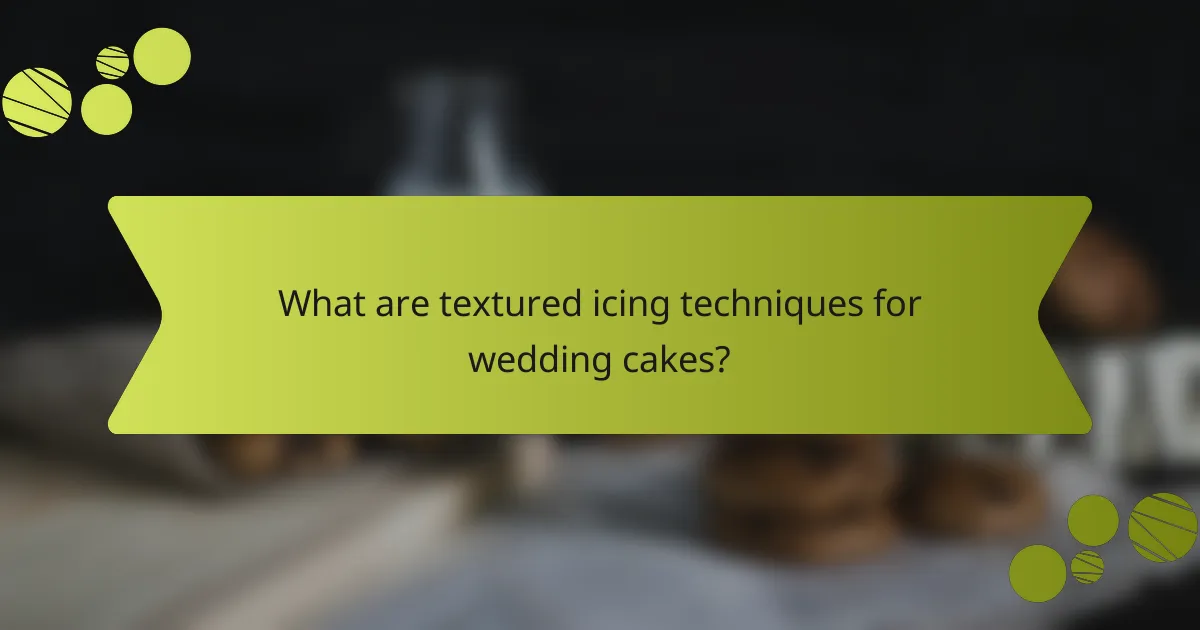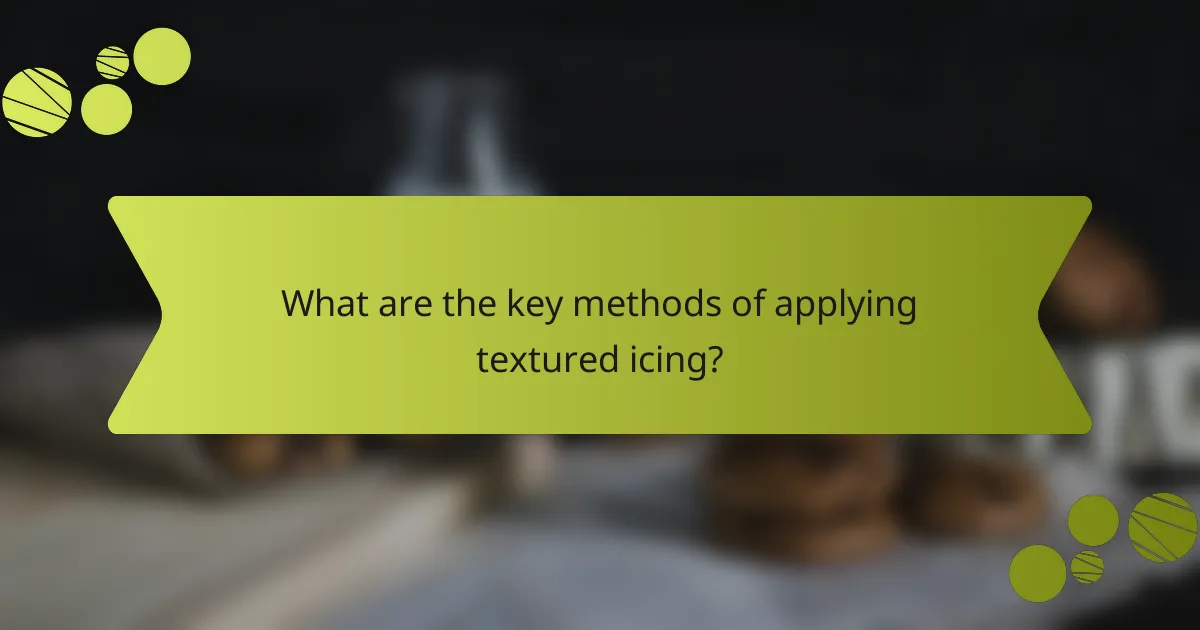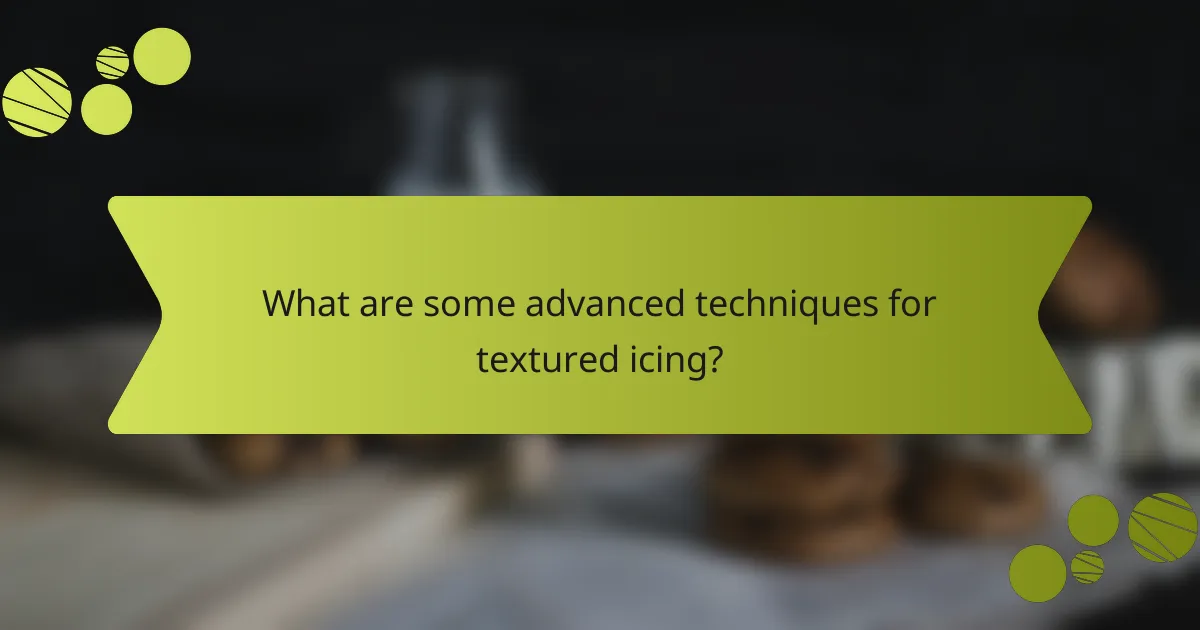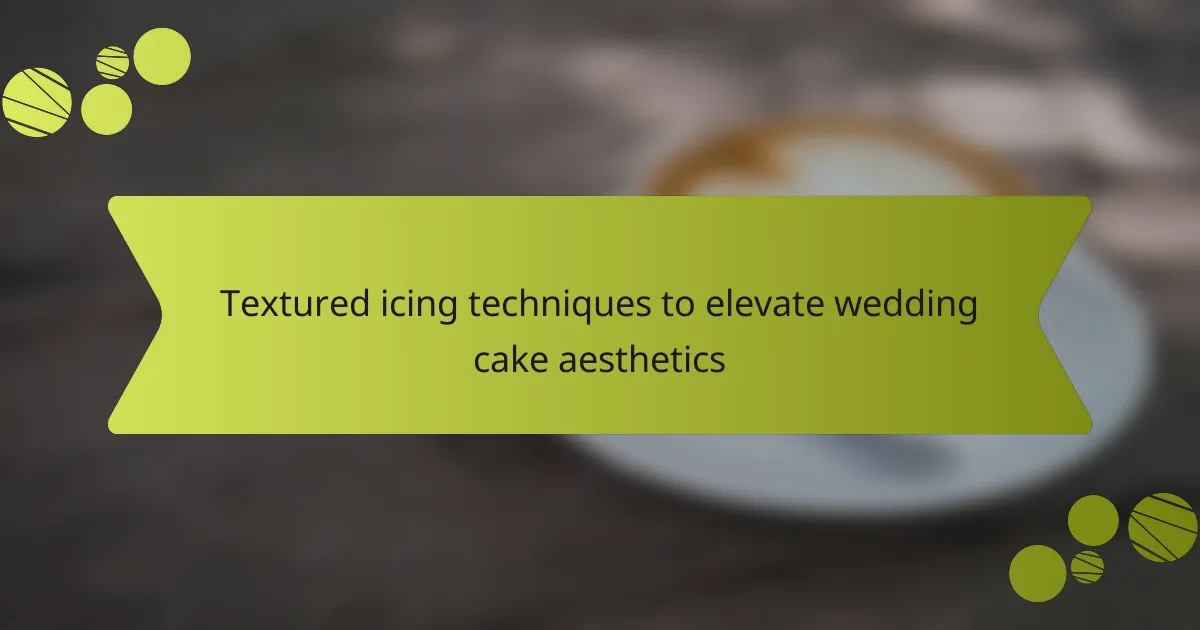Textured icing techniques are essential methods used to enhance the aesthetics of wedding cakes. These techniques include buttercream ruffles, fondant draping, and spatula patterns, each contributing unique visual elements to cake design. Key application methods involve spatulas, combs, and stencils, allowing for a variety of textures, from smooth swirls to intricate patterns. Advanced techniques such as airbrushing and piping further elevate the visual appeal, creating personalized and sophisticated cake surfaces. This article outlines the various techniques and tools available for achieving stunning textured icing on wedding cakes.

What are textured icing techniques for wedding cakes?
Textured icing techniques for wedding cakes involve various methods to create dimension and visual interest. Common techniques include buttercream ruffles, fondant draping, and the use of spatulas for patterns. Each technique adds a unique aesthetic to the cake. For instance, buttercream ruffles create a soft, romantic look. Fondant draping can mimic elegant fabrics. Spatula techniques allow for a more rustic finish. These methods enhance the overall design and personalization of wedding cakes. Textured icing can complement floral arrangements and other decorations effectively.
How do textured icing techniques enhance wedding cake aesthetics?
Textured icing techniques enhance wedding cake aesthetics by adding depth and visual interest. These techniques create patterns and designs that can complement the overall theme of the wedding. For instance, ruffles, swirls, and lace effects can evoke elegance and sophistication. Textured icing also allows for the incorporation of various colors and finishes, enhancing the cake’s appeal. Studies show that visually appealing cakes can increase guest satisfaction and engagement. The use of texture can transform a simple cake into a stunning centerpiece. Overall, textured icing techniques significantly contribute to the aesthetic value of wedding cakes.
What types of textures can be created with icing?
Icing can create various textures, each enhancing the visual appeal of cakes. Common textures include smooth, which provides a sleek finish, and ruffled, which adds dimension through layered folds. Other textures are piped, allowing for intricate designs like flowers or lace. Stippling creates a dotted effect, while marbled combines colors for a unique look. Additionally, textured icing can be achieved through techniques like combing, which creates lines, and splattering, which gives a playful appearance. These techniques are widely used in cake decorating to elevate aesthetics, especially for weddings.
How do different icing techniques affect the overall design?
Different icing techniques significantly impact the overall design of a cake. Techniques such as buttercream, fondant, and ganache each create unique visual effects. Buttercream can be piped into various textures, adding depth and dimension. Fondant provides a smooth, polished finish that enhances elegance. Ganache can create a glossy surface, adding richness to the appearance. Additionally, techniques like marbling or stenciling allow for intricate patterns and designs. The choice of icing technique influences not only aesthetics but also the cake’s theme and style. For instance, a rustic wedding cake may benefit from textured buttercream, while a formal event might call for sleek fondant. Each technique contributes to the cake’s overall impression and can align with the couple’s vision.
Why are textured icing techniques popular for weddings?
Textured icing techniques are popular for weddings because they enhance the visual appeal of cakes. These techniques add depth and dimension, making cakes more visually interesting. Textured icing can mimic various surfaces, such as lace, wood, or fabric, aligning with wedding themes. They allow for personalization, enabling couples to express their unique style. Additionally, textured icing can complement floral arrangements and other cake decorations. The popularity of these techniques is also supported by trends in wedding aesthetics that favor intricate designs. Overall, textured icing contributes to a memorable and elegant presentation at weddings.
What trends are influencing the use of textured icing in wedding cakes?
Current trends influencing the use of textured icing in wedding cakes include a focus on personalization and artistry. Couples are increasingly seeking unique designs that reflect their individual styles. Textured icing techniques, such as ruffles and waves, are popular for adding dimension and visual interest. Additionally, the rise of social media platforms has amplified the demand for visually striking cakes. Bakers are experimenting with various textures to create eye-catching designs that photograph well. Sustainability is also a growing trend, leading to the use of natural ingredients in icing. These factors collectively shape the evolving landscape of wedding cake aesthetics.
How do couples choose textured icing for their wedding cakes?
Couples choose textured icing for their wedding cakes based on personal style and theme. They often consider the visual appeal of various icing techniques. Popular options include buttercream, fondant, and royal icing. Each type offers different textures, such as smooth, ruffled, or piped designs. Couples may also look at wedding cake trends for inspiration. They often gather ideas from wedding magazines and social media platforms. Taste is another important factor; couples may sample different icings before making a decision. Ultimately, the choice reflects their unique preferences and wedding vision.

What are the key methods of applying textured icing?
The key methods of applying textured icing include using spatulas, combs, and stencils. Spatulas create smooth or swirled textures by spreading icing in various patterns. Combs, with their serrated edges, produce ridges and grooves for a more defined texture. Stencils allow for intricate designs by applying icing over a cut-out pattern. Each method enhances the visual appeal of wedding cakes. These techniques can be combined for unique effects, offering versatility in cake decoration.
How can fondant be used to create textured effects?
Fondant can be used to create textured effects by employing various techniques. One method is to use textured rolling pins, which imprint patterns onto the fondant surface. Another approach is to hand-sculpt details using tools like modeling sticks or ball tools. Fondant can also be layered or draped to create dimension. Additionally, it can be painted or dusted with edible powders to enhance texture visually. These techniques allow decorators to achieve intricate designs, contributing to the overall aesthetics of wedding cakes. Textured effects can elevate a cake’s appearance, making it more visually appealing and unique.
What tools are essential for achieving fondant textures?
Essential tools for achieving fondant textures include a fondant smoother, rolling pin, and texture mats. A fondant smoother helps create a sleek surface on the fondant. A rolling pin is used to roll out the fondant to the desired thickness. Texture mats allow for intricate designs to be pressed into the fondant. Additionally, a crafting knife is useful for cutting and shaping fondant. A paintbrush can help apply edible luster dust for added shine. Finally, a silicone mold can create unique shapes and patterns in the fondant. These tools are widely recognized in cake decorating for their effectiveness in achieving professional-looking fondant textures.
What techniques can be employed for fondant texturing?
Techniques for fondant texturing include using embossing mats, rolling pins with patterns, and texture sheets. Embossing mats create detailed designs by pressing fondant into the mat. Rolling pins with patterns can imprint textures directly onto the fondant surface. Texture sheets are flexible and can be pressed onto fondant for various designs. Other techniques include hand-painting, airbrushing, and using tools like spatulas or brushes for additional effects. Each method allows for unique finishes that enhance the visual appeal of wedding cakes.
What role does buttercream play in textured icing techniques?
Buttercream serves as a foundational medium in textured icing techniques. It provides a smooth and stable surface for creating various designs. Its pliability allows for easy manipulation into different textures. Buttercream can be piped, spread, or sculpted to achieve desired effects. The fat content in buttercream contributes to its stability and durability. This stability is crucial for maintaining intricate designs on wedding cakes. Additionally, buttercream can be tinted to match wedding color schemes. Its versatility makes it a popular choice among cake decorators for textured icing.
How can various buttercream styles create different textures?
Various buttercream styles can create different textures through their unique preparation methods and ingredient ratios. For example, Swiss meringue buttercream is smooth and creamy due to the incorporation of heated egg whites. This style results in a silky texture that is ideal for spreading and piping. In contrast, American buttercream is thicker and more sugary, leading to a denser texture that holds its shape well. Italian meringue buttercream combines cooked sugar syrup with whipped egg whites, resulting in a light and airy texture that is less sweet than American buttercream. Additionally, adding ingredients like cream cheese or cocoa powder can alter the texture. Cream cheese buttercream is tangy and slightly thicker, while chocolate buttercream is rich and velvety. Each style’s unique preparation and ingredient choices directly influence the final texture, allowing for diverse aesthetic applications in wedding cake designs.
What are the best practices for working with buttercream textures?
The best practices for working with buttercream textures include ensuring the butter is at room temperature. This allows for easier mixing and smoother textures. Use high-quality butter for a richer flavor and better consistency. Incorporate powdered sugar gradually to avoid lumps and achieve a fine texture. When adding color, use gel food coloring to maintain the buttercream’s consistency. For smooth applications, use a bench scraper to create even surfaces. To create texture, utilize various tools like spatulas or combs. Keep the buttercream cool to prevent melting during decorating. Lastly, practice different techniques to master the desired textures effectively.

What are some advanced techniques for textured icing?
Advanced techniques for textured icing include using a palette knife for smooth swirls, employing a piping bag for intricate designs, and utilizing fondant for a polished finish. Additionally, incorporating tools like combs and spatulas can create unique patterns. Airbrushing can add depth and dimension to the texture. Stencils can also be used for detailed designs. These methods enhance visual appeal and create unique cake surfaces. Textured icing techniques are essential for elevating wedding cake aesthetics.
How can royal icing be used for intricate textures?
Royal icing can be used for intricate textures by adjusting its consistency and employing various piping techniques. A stiffer royal icing is ideal for creating detailed designs like lace or filigree. Thinner royal icing can be used for flooding techniques, allowing for smooth surfaces that can later be textured. Piping bags with different nozzle sizes help achieve diverse patterns and textures. Techniques such as brush embroidery and stenciling can enhance the visual appeal of the icing. Additionally, using a comb or spatula can create unique surface textures. Royal icing dries hard, ensuring that intricate designs maintain their shape. This versatility makes royal icing a popular choice for detailed cake decorations.
What are the steps to create detailed designs with royal icing?
To create detailed designs with royal icing, start by preparing the royal icing. Mix egg whites or meringue powder with powdered sugar and water until it reaches a stiff consistency. Next, divide the icing into separate bowls for coloring. Use gel food coloring to achieve desired shades, mixing thoroughly. Once colored, transfer the icing into piping bags fitted with fine tips. Begin by outlining your design on the cake or cookies using a steady hand. Fill in the outlined areas with the same icing, smoothing it out with a small spatula or a toothpick. Allow the icing to dry completely, which may take several hours or overnight. For additional details, use a thinner icing to pipe smaller designs or embellishments. Finally, consider adding edible glitter or luster dust for a finishing touch.
How does royal icing compare to other icing types for texture?
Royal icing has a smooth, hard texture when dried, making it ideal for intricate designs. In contrast, buttercream is softer and creamier, providing a more spreadable consistency. Fondant offers a pliable, smooth surface that can be rolled out for a sleek finish. Royal icing dries quickly and hardens, allowing for detailed piping work and structural support. Buttercream remains softer and can be easier to manipulate for a variety of textures. Each icing type serves different aesthetic purposes in cake decoration.
What innovative tools can enhance textured icing techniques?
Innovative tools that can enhance textured icing techniques include silicone molds, icing combs, and airbrush kits. Silicone molds allow for precise shapes and patterns, creating intricate textures easily. Icing combs come in various designs to add dimension and style to the icing surface. Airbrush kits enable the application of color gradients and shading, enhancing the visual appeal of textured icing. These tools are widely used by professional cake decorators to achieve high-quality finishes. The combination of these tools can significantly elevate the aesthetics of wedding cakes.
Which specialized tools are recommended for creating textures?
Recommended tools for creating textures in icing include a textured rolling pin, silicone molds, and spatulas. Textured rolling pins imprint designs onto fondant or icing, adding dimension. Silicone molds allow for intricate patterns and designs to be easily transferred. Spatulas can create smooth or rough textures depending on the technique used. These tools are essential for achieving professional-looking finishes on wedding cakes.
How can technology improve the application of textured icing?
Technology can improve the application of textured icing through advanced tools and techniques. Precision icing dispensers allow for consistent application of patterns. These devices can control flow rate and pressure, ensuring uniformity. 3D printing technology enables intricate designs that are difficult to achieve by hand. Digital temperature control systems maintain optimal icing consistency. This reduces the risk of melting or hardening too quickly. Additionally, software applications can assist in designing and visualizing icing patterns before application. These innovations enhance both the efficiency and quality of textured icing on wedding cakes.
What tips can help achieve the best results with textured icing?
To achieve the best results with textured icing, ensure proper consistency. The icing should be thick enough to hold shape but not too stiff to spread. Use a spatula or palette knife for creating textures. Experiment with different tools like combs or brushes for varied effects. Apply the icing in layers for depth and interest. Allow each layer to set before adding more texture. Practice on a dummy cake to refine techniques without pressure. Use high-quality ingredients for better flavor and stability.
How can one troubleshoot common issues with textured icing?
To troubleshoot common issues with textured icing, first identify the specific problem. If the icing is too runny, reduce the liquid content or add more powdered sugar. For a gritty texture, ensure all ingredients are well-mixed and sifted. If the icing is cracking, it may be too dry; add moisture gradually. If the texture is uneven, use a smoother tool or adjust your technique. For discoloration, check the freshness of ingredients and avoid exposure to heat. Each of these solutions addresses typical problems encountered with textured icing, ensuring a better finish for wedding cake aesthetics.
What are the best practices for maintaining texture during transport?
To maintain texture during transport, ensure cakes are securely boxed. Use sturdy cake boxes that prevent movement. Avoid stacking cakes unless necessary, as this can compress textures. Refrigerate cakes prior to transport to solidify textures. Use non-slip mats in transport vehicles to minimize sliding. Limit exposure to heat, as it can alter icing consistency. Keep cakes upright at all times during transport. These methods help preserve the intended texture of the cake.
Textured icing techniques are essential methods used to enhance the aesthetics of wedding cakes, creating dimension and visual interest through various styles such as buttercream ruffles, fondant draping, and intricate piping. These techniques not only complement the overall wedding theme but also allow for personalization, reflecting the couple’s unique style. The article explores different types of textures, the impact of icing techniques on cake design, and current trends influencing their popularity. Additionally, it covers essential tools and best practices for achieving and maintaining texture, troubleshooting common issues, and ensuring the cake’s visual appeal during transport.
